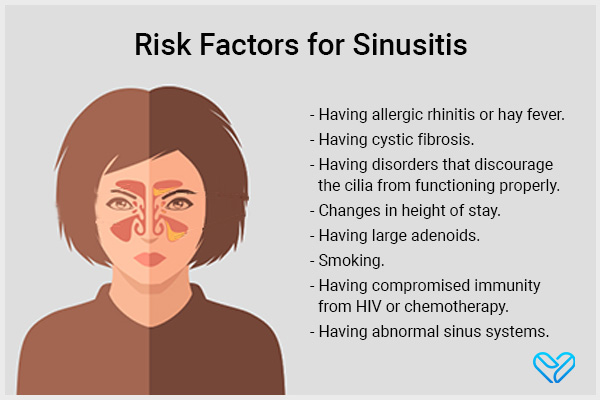In this article:
Sinus infections, also known as sinusitis, are a common and bothersome health issue affecting millions of people in the United States. Each year, Americans spend a significant amount of money on over-the-counter remedies and prescription medications to tackle sinus infections.

The condition can be caused by bacterial, viral, or fungal infections, and certain factors such as allergies, asthma, structural blockages, and weakened immune systems can increase the risk of developing a sinus infection. (1)
Sinusitis occurs when the sinuses, which are air-filled cavities located in various areas of the face and skull, become inflamed.
Normally, a thin layer of mucus lines the sinuses, trapping dust, germs, and particles. Tiny hair-like structures called cilia then move this mucus toward the back of the throat where it is eventually swallowed.
However, during a sinus infection, the flow of mucus is disrupted due to the swelling of the nasal tissues caused by infections or allergies. This swelling obstructs the cilia and leads to mucus accumulation in the sinuses. (1)
Types of Sinusitis
There are three types of sinusitis: (2)
- Acute sinusitis lasts up to 4 weeks or 30 days and is typically caused by bacterial growth.
- Chronic sinusitis persists for over 3 months and can be caused by bacteria or fungus.
- Subacute sinusitis lasts between 1 and 3 months (30–90 days).
Note: Experts also talk about recurrent sinusitis, which can be explained as recurring episodes with symptom-free intervals of at least 10 days.
Causes of Sinusitis
Sinusitis can be caused by various factors, including cilia (small hairs) in the sinuses not moving mucus properly and colds or allergies that cause excessive mucus production. (2)
In some cases, individuals may have structural defects that contribute to chronic sinus infections. These defects include a misshapen bony partition between the nasal passages, the presence of nasal polyps (noncancerous growths filled with mucus), and narrowed sinus openings. These abnormalities can increase the likelihood of experiencing recurrent sinus infections. (1)
Symptoms of Sinusitis
Common symptoms of sinusitis include: (1)
- Runny nose and cough
- Postnasal drip, which makes you feel like needing to constantly clear your throat
- Nasal stuffiness or congestion
- Discolored nasal discharge
- Facial soreness, especially under the eyes or at the bridge of the nose
- Swelling over the affected sinus
- Bad headaches, usually because of frontal sinusitis
- Aching teeth, especially the upper ones, in maxillary sinus infections
- Fever
- Bad breath
Treatment for Sinusitis

Treating sinus infections involves the following: (3)
- Antihistamines aren’t really helpful for most sinus infections, and they can even make things worse by making it harder for your sinuses to drain.
- Topical steroids are often more effective, especially for chronic or allergic sinusitis.
- Antibiotics such as amoxicillin, penicillin, and erythromycin are commonly prescribed for 12–14 days in acute cases and up to 6 weeks in chronic cases.
Note: Overall, treatment usually lasts for 5–14 days depending on your age and the severity of your infection. In some cases of recurrent sinusitis, surgery may be necessary to improve sinus drainage. (3)
Testing for and Diagnosing Sinusitis
When diagnosing a sinus infection, doctors primarily rely on clinical assessment rather than laboratory tests.
In children, sinusitis is suspected when thick, colored nasal discharge lasts for more than 10 days, along with tiredness and cough. Fever is rare, but there may be discomfort in the face.
While a plain sinus X-ray can be helpful in detecting certain types of sinus diseases, a more accurate diagnostic tool is a coronal CT scan, which can identify air-fluid levels, sinus wall displacement, and mucosal thickening. (3)
Note: Culture and biopsy tests are only necessary for chronic bacterial and fungal sinus infections.
Risk Factors of Sinusitis
Some factors that can increase your risk of developing sinusitis include: (2)

- Allergic rhinitis or hay fever
- Cystic fibrosis
- Disorders that discourage the cilia (tiny hair-like structures in your nose) from functioning properly
- Altitude changes (flying or scuba diving)
- Large adenoids (small pads of tissue located at the back of the nose)
- Smoking
- Compromised immunity from HIV or chemotherapy
- Abnormal sinus systems
When to See a Doctor
It’s important to see a doctor if your sinus infection symptoms last longer than 10 days, worsen, or become severe, you have a high fever, experience severe facial pain or headaches, notice changes in vision or eye swelling, have persistent or worsening nasal discharge, suffer from recurrent or chronic sinus infections, or have difficulty breathing.
Seek medical attention for proper evaluation and guidance.
Final Word
Home remedies can be effective in managing the symptoms of sinusitis. However, if your symptoms persist or worsen, it is important to seek medical attention.
Additionally, it is essential to practice good hygiene and avoid irritants to prevent the recurrence of sinusitis.
 Continue Reading7 Home Remedies to Help Clear Up Sinus Infection
Continue Reading7 Home Remedies to Help Clear Up Sinus Infection
- Was this article helpful?
- YES, THANKS!NOT REALLY


